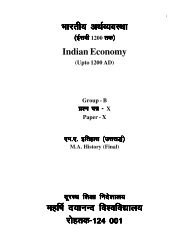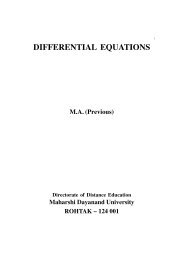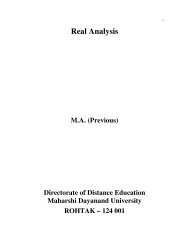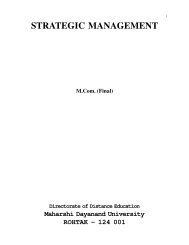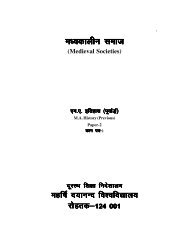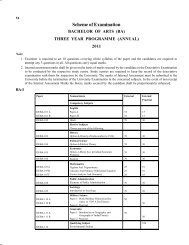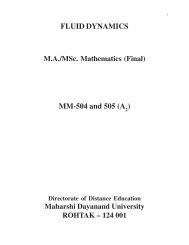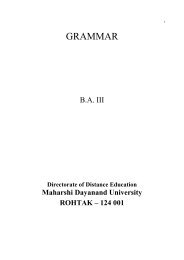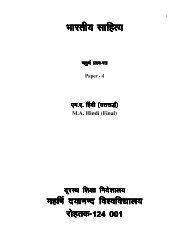LITERATURE AND GENDER - Maharshi Dayanand University, Rohtak
LITERATURE AND GENDER - Maharshi Dayanand University, Rohtak
LITERATURE AND GENDER - Maharshi Dayanand University, Rohtak
You also want an ePaper? Increase the reach of your titles
YUMPU automatically turns print PDFs into web optimized ePapers that Google loves.
Tennessee Williams: A Street Car Named Desirecontrast between the delicate and refined Blanche on the one hand and on the other rough and tough Stanley. Seen inthe surrealistic lights of the play, the two look like the fairy and the brute, the moth and the hyena. The very symbolismof the play is meant to get over the limitations of the realistic mode. It takes away the colourlessness of ordinariness andpresents reality in sharpened and darkened colours. The play may not match a romantic tragedy of the Elizabethan age,it does come up to the tragic level, making the story of Blanche a moving experience, leaving the reader sad but civilized.(4) Blanche as Tragic HeroineIn tragedy, product as it was of the tribal, feudal and aristocratic societies, the dias has been heavily set againstwomen. In fact, in the ancient tribal Greek societies, there was still a possibility that the woman would find a place,although not usually, in the world of tragedy, but there was no place for woman in the tragedies of feudal andaristocratic medieval societies. Even in Elizabethan England, woman was not considered good enough for occupyingthe central slot in tragedy. In Greek tragedy, we could still have an Antigony or Electra, but in the Elizabethan tragedy,we can only have secondary roles for them like that of Ophelia or Cordelia. The conventional binaries of man/woman,strong/weak, outdoor/indoor were strong beliefs in the Christian societies even until the Elizabethan age. In thishierarchical belief about man/woman relationship, while man is considered the master (‘my lord’), woman is a servingsecond; while man is strong, woman is weak; while man is an outdoor performer, woman is an indoor doer. With theseideas, having a very strong prejudiced view of woman, she would naturally remain a character to perform secondaryroles, subsidiary to man’s.These conventional images of man and woman are actually derived from the mythologies. Greek or Christian, womanis viewed as next to man, created only to create problems of man. Pandora, the first woman in Greek mythology, issent to punish Prometheus, the first man. We know how Pandora’s box is considered a container for all the ills andevils of the world. Similarly, Eve, the first woman in Christian mythology, became the cause of the fall of man.Thereafter, she was branded as the weaker sex, the second sex, with weakness not merely physical but also moral.“Frailty thy name is woman,” says the hero in Shakespeare’s tragedy Hamlet. This conventional view has remainedfor centuries so strongly stamped on the womankind that the gender has been for all these long years on the receivingend, subjected to all sorts of humiliations and indignities. Even as late as eighteenth century could poets like Popethrow all sorts of funny comments on women. “Women and watches never agree” is one such remark he makes inone of his poems. Even as late as the Victorian age, Tennyson, the poet laureate, neatly assigned only the domesticduties to women, leaving the outdoor world of action an exclusive domain for the male.Although Williams was not a crusader for women, his closer affinity with his grandmother, mother and sister, anddistance from his father, made him understand the plight and position of women in the American society. LikeHawthorne, Williams had an advantage over most of his contemporaries in that he was able to develop greatersensitivity to the concerns of women. No wonder then that he places Blanche at the center of his play’s pattern orplot. Her status as a tragic heroine has been debatable for more than one reason. The problem with Blanche is thatshe is made a battleground for either the psychological forces of illusion and reality, or for the historical forces of adying culture and a growing violent way of life. Both these conflicts tend to reduce the character of Blanche into asymbolic figure rather than an actual living person struggling against the odds of life. No doubt, she tries to hold on toher position, even if it is illusory, resisting the aggression of the brute force that Stanley represents. But her fightseems so unequal in the play that she comes out more pathetic than tragic, more like Ophelia than Hamlet or Antigone.Williams depicts in Blanche the total defeat of a woman whose existence depends on her maintaining illusions aboutherself and the world. She is both a representative and a victim of a tradition that taught her to believe that attractiveness,virtues, and gentility led automatically to happiness. But reality proved intractable to the myth. Blenche’s lot was BelleReve, with its debts and deaths, and homosexual husband who killed himself because, for once, her sensitivity failsher. Blanche’s “amatory adventures…are the unwholesome means she uses to maintain her connection with life, tofight the sense of death which her whole background has created in her.” Since “the tradition” allows no place for thephysical and sensual, she rejects this aspect of her personality, calling it “brutal desire.” As Kazin writes, “She thinksshe sins when she gives into it…yet she does give into it, out of loneliness…but by calling it ‘brutal desire,’ she is ableto separate it from her ‘real life,’ her ‘cultured,’ refined self.” If Blanche is the last remnant of a moribund culture,15



